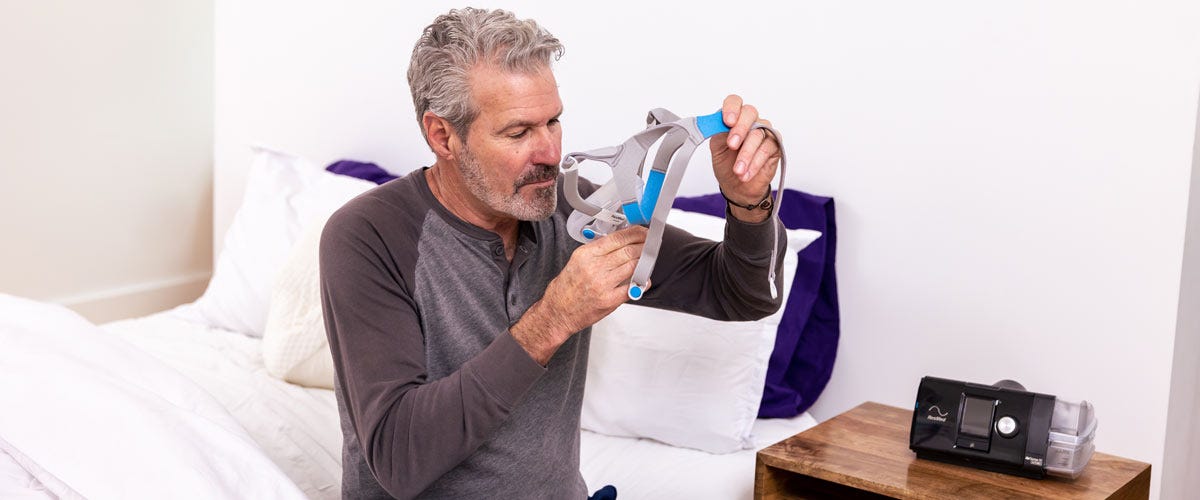Your CPAP mask is the primary interface between you and your CPAP machine, and it might just be the biggest factor in determining how well you adjust to your sleep apnea treatment. It works hard night after night and over time its performance can be weakened by normal wear and tear. Learn exactly how and when to replace your CPAP mask to get the most out of your CPAP therapy.
There are a few clear signs that it’s time to replace your CPAP mask:
- When there is discoloration of the seal
- When the seal feels rough and uncomfortable against your skin
- When your notice air leaks
- If the mask headgear becomes stretched, loose, or frayed
- If the mask doesn’t fit anymore
- If the frame is bent
- If your mask starts making unusual noises


Why Do I Need To Replace My CPAP Mask?
Just like all other medical equipment, your CPAP mask needs to stay in tip top shape. It should be clean and comfortable, yet secure enough to withstand the air pressure needed to keep you breathing normally all night. When a CPAP mask becomes loose or begins to leak air, you aren’t getting the full treatment recommended by your doctor, and pauses in breathing (apneas) become more and more likely, leading to a whole host of health risks that are not to be taken lightly.
An apnea event lowers your blood oxygen levels and triggers your body to release stress hormones, forcing you to wake up and breathe again so you don’t suffocate. This rapid wake up process causes a spike in heart rate and high blood pressure, putting you at a higher risk of heart attack, stroke, hypertension, and heart failure.
How Do I Know When To Change My CPAP Mask?
CPAP masks are generally made of soft materials like plastic or silicone to provide an effective seal while you sleep. But over time, these materials can break down as they come into contact with the facial oils and dead skin cells.
As the seal deteriorates and the mask leaks, you’ll need to compensate for the poor seal somehow. All of a sudden you’ll have to keep tightening your headgear to keep the cushion in place and the frame on your face. This can make the mask feel too tight and cause pressure marks and skin irritation. It can also cause the headgear to stretch and eventually break.
Not only does a worn out mask mean you won’t get your full dose of pressurized air, you could also make yourself sick. You can only keep an older mask clean for so long. As abrasion causes materials to become worn down, your CPAP mask can develop micro tears that build up bacteria, allergens, viruses, and other harmful pathogens, all of which can get forced into your mouth and lungs via the continuous positive airway pressure. This is another reason why regular replacement of your supplies is crucial.
How Often Should I Replace My CPAP Equipment?
The components that make up your mask need to be replaced in different time frames. The replacement schedules are determined by manufacturers and clinicians to keep your equipment effective.
Cushions and Pillows: Full face mask cushions, as well as nasal cushions and pillows should be replaced every 14 days.
CPAP Mask Frame: Your CPAP mask frame is connected the cushion and headgear. It needs to be replaced once every three months.
CPAP Tubing: Your CPAP hose delivers air from the CPAP machine to the mask and needs to be replaced once every three months.
CPAP Headgear and Chin Strap: These are made of soft, flexible materials that can lose elasticity over time. They should be replaced once every 6 months.
Humidifier Water Chamber: These should be washed out after every use with distilled water and replaced every 6 months.
It may seem like a lot to keep track of, but at CPAPSupplies, we keep you on schedule for replacement parts so you don’t have to worry about it. Your new CPAP supplies will automatically arrive right on time, so you won’t have to deal with remembering each part’s lifespan.
About once a year check out the newer, advanced masks with innovative comfort features. You might find a new favorite. Plus, if your primary mask breaks down, you’ve got an alternative on hand. Our 30 day mask guarantee means that if your mask doesn’t fit, you can return it within 30 days and you’ll get the full amount towards a new mask!
Cleaning Your CPAP Mask
To expand the lifespan of your CPAP mask, be sure to clean it according to manufacturer directions. Disconnect the mask from the tubing and disassemble all of the parts. Place your CPAP mask parts in warm soapy water and swirl them around for about five minutes. Thoroughly rinse each piece and allow them to completely air dry before reassembling your mask. Then thoroughly wash each part and hand them up to dry before putting your mask back together.
While CPAP sanitizing machines are not a replacement for regularly handwashing your mask, they are an excellent complement to it. If you happen to fall short of the recommended cleaning schedule, you may consider a sanitizing machine like the Paptizer to reduce the risk from harmful bacteria or viruses between cleanings. It uses UV-C LEDs (no harmful chemicals) to kill up to 99.9% of bacteria in as little as 3 minutes.













